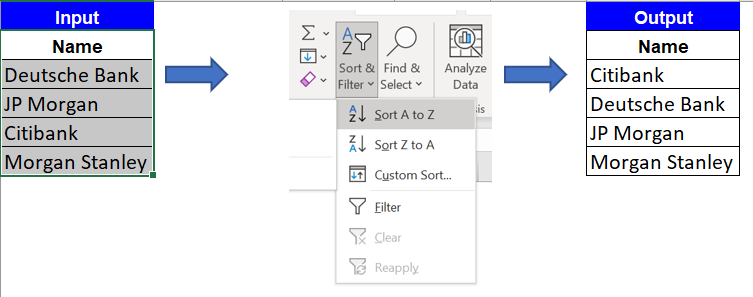SORTING in Excel: Explained
In this article, you will learn how to SORT data in Excel.
Uses of Sorting:
Sorting in Excel allows you to arrange and organize the data and cane be useful in a variety of situations like below:
- Data organization: Sorting can help you quickly organize and categorize large sets of data. For example, you can sort a list of employees alphabetically by last name or sort a list of sales data by date.
- Data analysis: Sorting can help you quickly identify patterns and trends in your data. For example, you can sort a list of sales data by product or customer to see which products or customers are generating the most revenue.
- Data filtering: Sorting can be used in conjunction with filters to quickly and easily find specific data. For example, you can sort a list of customer data by city and then filter to show only customers in a specific city.
- Data cleaning: Sorting can help you identify and remove duplicates or errors in your data. For example, you can sort a list of names to quickly identify and remove duplicates.
Types of Sorting
- Sorting data alphabetically or numerically: You can use Sorting to arrange data in a row alphabetically or numerically. This can be useful when you want to group similar data together.
- Sorting by colour: You can use the Sort function to arrange data by cell colour, font colour, or icon. This can be useful when you want to group data that has similar characteristics, such as high or low values.
- Sorting by multiple columns: You can use the Sort function to arrange data by multiple columns. For example, you might sort data first by region, then by product, to see which products are selling best in each region.
- Sorting by custom criteria: You can use the Sort function to arrange data based on custom criteria that you specify. For example, you might sort data by sales volume, but give more weight to sales made in the current quarter.
How to Sort Data in Excel:
- Select the range of cells that you want to sort.
- Click on the "Sort & Filter" button in the ‘Home’ tab of the Ribbon.
- Click on the "Sort A to Z" or "Sort Z to A" button to sort the data in ascending or descending order respectively. You can use this to arrange data in a row alphabetically or numerically.
- You can also click on "Custom Sort" to sort by multiple columns, specify a custom sort order, or sort by cell colour, font colour, or icon.
- In the Custom Sort dialog box, select the column that you want to “Sort by”, and choose the “Order” (ascending or descending).
- If you want to sort by multiple columns, click on "Add Level" and repeat step 4.a for each additional column.
- Click “OK” to apply the sort.
Case 1: If you want to sort the data alphabetically on single column: A to Z

Case 2: If you have multiple columns and you want to sort the entire data based on values in one of the columns:

Keyboard Shortcut to Sort Data
In Microsoft Excel, the keyboard shortcut to sort data is:
Step 1: Select the range of cells you want to sort
Step 2: Press the following key combinations for the sorting options
- Ascending - Press Alt + A + S + A
- Descending - Press Alt + A + S + D
- Custom Sort - Press Alt + A + S + S - This will bring up the Sort dialog box where you can select the columns to sort by and the sort order.

